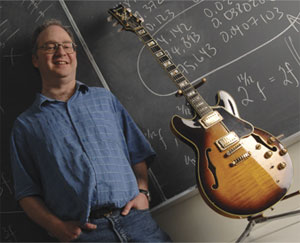 |
| Math prof Jason Brown and his Ibanez guitar.(Danny Abriel Photo) |
All you need is love? All you need is cheese?
Apparently, all you need is math. Or so says math professor Jason Brown, who recently entertained students, faculty and community members with a crowd-pleasing lecture exploring the connections between math and music. Â
Dr. Brown, who gained worldwide attention by using mathematics to decipher the opening chord of The Beatles' A Hard Day's Night, set out to once again demonstrate the math-music relationship by first tackling the topic of âunderstanding the physics and physiology of sound and music.â He added mathematical insight to the everyday occurrence of sound, such as high notes, which are perceived as higher because they are travelling faster. He also stressed the importance of âunderstanding the role of patterns, transformations and ambiguity in music.â He used math to explain the effectiveness of a 12-bar Blues chord progression, and to explain the âcatchyâ nature of The Beatlesâ I Want to Hold Your Hand.
The lecture ended with a music video of Dr. Brownâs mathematically synthesized song which he created in the style of The Beatles by following and expanding principles he found in their music. The lecture was enjoyable because it illustrated mathematical concepts with relatable examples from well-known artists such as Joni Mitchell and Chuck Berry.
Author of the book Our Days Are Numbered, Dr. Brown raises many interesting questions pertaining to music from both the point of view of a listener and a composer. He has undertaken many of these questions as research projects, such as the dilemma of âhow many âniceâ sounding chords are in a scale,â which he co-investigated with a student. By sharing his discoveries, he hopes to teach young musicians that âmathematics, even in its most basic forms, is an essential and useful tool in the analysis and synthesis of music.âÂ
He also reaches out to researchers of other disciplines, urging them to take a creative academic approach by exploring their interests from a fresh and different perspective. âThe most interesting areas for research are the areas between fields,â he says.
The next music mysteries that Dr. Brown hopes to unravel with math are questions of music authentication.
